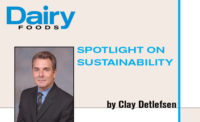Consumers want sustainable food packaging. Food manufacturers want to use sustainable packaging. Many packaging suppliers are striving to meet marketplace demands. But we live in an imperfect world and we can’t always get what we want. That said improvements are being made and have been made over the years.
A discussion about sustainable packaging would not be complete without an exploration of two very sustainable packaging materials: milk jugs and milk crates.
Milk jugs made out of high-density polyethylene (HDPE) today have considerably less plastic resin in them than when I was a kid. And in fact, milk jugs today are about as thin as they can possibly get, as we learned during the post-Katrina plastic shortage. Any thinner and their integrity is at risk. In addition to downsizing the mass, milk jugs are now recycled at a rate that hovers around 30%. In contrast, the glass container’s recycling rate runs around 28%, although aluminum peaks at just over 50%.
A little known FDA letter
While there is some room for improvement on the U.S. recycling rate, a recent development might help spur an increase. Interestingly, on June 5, 2012, FDA’s Office of Food Additive Safety issued a no objection letter acknowledging the capability of a proposed recycling process to produce safe postconsumer recycled high-density polyethylene (PCR-HDPE). As proposed, it is suitable for use at levels of up to 50% recycled content in the manufacture of HDPE containers for contact with fresh milk or juices.
FDA, however, has imposed several conditions. First, processors are precluded from thermally treating product in the container. Given that we don’t do that anyway, there is no problem there. Second, and more importantly, the no objection letter states the PCR-HDPE must come from milk containers only. That may be a problem. How does one create a milk container only input stream that a PCR-HDPE manufacturer could utilize to make its recycled resin?
Finally, the no objection is limited to an Austrian company, Starlinger, for their decontamination process to make food grade flakes. Any other technology that is developed to accomplish the same endpoint would need a separate approval from FDA.
There is some uncertainty about whether the Office of Food Additive Safety’s determination is the final word from the entire FDA. All this said, there are a lot of ingenious folks out there who have an interest, so I suspect in time this will develop.
While you are waiting for the PCR-HDPE market to develop, you could always turn to using biodegradable plant-derived polylactic acid for some applications. PLA packaging produces significantly less greenhouse gases, perhaps up to 60% less, than its petroleum-based cousins, polyethylene terephthalate (PET) and polystyrene.
Chalk one up for calcium carbonate
Calcium carbonate, commonly known as chalk, is another plastic replacement option. Calcium carbonate is used as a filler for the resin and it can have a number of beneficial properties. These include lowering blow mold exit temperatures by as much as 25% and faster cycling of blow molding, theoretically up to 30%. According to at least one calcium carbonate supplier, food packaging can contain as much as 40% to 50% calcium carbonate depending on the application and it has a considerable lower energy footprint than resin. The inclusion of calcium carbonate in the plastic does not alter its recyclability, and it actually has a beneficial effect during incineration by reducing acids in the emissions.
Now let’s turn to my favorite sustainable package — milk crates. Milk crates are earth-friendly. The plastic milk crate is the only secondary packaging needed for milk delivery. No cardboard or plastic wrap is used, which means no waste. Plastic milk crates stand up to extreme temperatures, take abuse and last years and years before they need to be recycled into new crates.
Show some love for the crate
But every time someone takes an empty milk crate, a replacement crate must be manufactured. This means four pounds of plastic resin must be created, molded and shipped. This produces greenhouse gases that would not have occurred if the crate had not been diverted from its mission. The dairy industry is losing almost 20 million crates per year, the equivalent of approximately 1.34 billion plastic water bottles.
Most milk crates disappear because of outright criminal theft, not misuse or misappropriation. These criminals in many cases are loosely organized criminal enterprises who steal virtually anything they can get their hands on, from metals to plastic, and sell it for scrap. Law enforcement is getting up to speed on the issue, and enforcement is active on the East and West Coasts.
In contrast to theft for profit, usually law-abiding citizens snatch up milk crates while they are waiting to be picked up by dairies. Unfortunately, too many of these crates wind up in landfills, in the woods or in or along riverbeds when they are no longer needed.
The dairy industry is continuing to push forward with sustainable packing on a variety of fronts, including some not mentioned here. I think the years ahead will yield some interesting and beneficial results. So, yes, we can get what we want as well as what we need.




